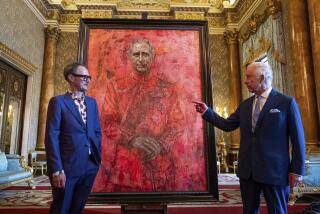The New Face of Shakespeare
- Share via
James Joyce, first among modernist equals, found his influence so all-encompassing that he habitually referred to him as “Shakesphere.”
Ralph Waldo Emerson, philosopher and man of letters, assessed him as “inconceivably wise,” while all other writers--whatever their genius--were merely “conceivably so.”
But to Sir Frank Kermode, perhaps this era’s preeminent Shakespeare reader, the poet and playwright was “always, indeed, a writer and to be considered as such.”
It is that fact of individual humanity freighted with genius that renders so fascinating the recent emergence in Canada of a small, apparently authentic Elizabethan painting whose owner believes it to be the only existing contemporaneous portrait of the Bard of Avon.
In literary terms, the search for the historical Shakespeare occupies territory rather like that where the quest for the historic Jesus occurs--an area of nearly addictive interest, strewn with contested facts and riven by theological differences. In such a place, the possibility that there may exist an actual portrait of Shakespeare at the height of his powers is fraught with the sort of implications usually associated with the Shroud of Turin.
Naturally enough, the alleged portrait has set the Internet’s virtually innumerable Shakespeare-related sites into a cyber-spatial quiver. Professor Alan H. Nelson, a UC Berkley Shakespeare scholar, even has posted a copy of the portrait on his influential Web site, though he is quick to point out that he “has no opinion on its authenticity. . . . But it’s fun to speculate.”
Others are less measured. British playwright Tom Stoppard is insistently indifferent to the picture’s possibilities; his American colleague Amy Freed is passionately enthusiastic. To Freed, the portrait’s physical impact “is so thrilling that we should stop all attempts to authenticate it and just embrace it now.” Part of what attracts her is the picture’s pure sexiness. Director Jonathan Miller, however, diagnoses decadence in our fascination with the whole affair.
The picture’s existence and unusual history first came to light in a recent edition of Toronto’s Globe and Mail. The painting’s owner, who insists on anonymity for what he says are security reasons, is a retired engineer living in a mid-sized city in the province of Ontario. The portrait is part of a collection the man’s father brought with him when he emigrated from England to Canada early in the last century.
The painting, rendered in tempera on an oak panel, bears the likeness of an informally dressed young man with a high forehead, auburn hair and blue-green eyes--the latter two being physical characteristics ascribed to Shakespeare in a description attributed to his contemporary, Christopher Marlowe. The sitter’s mouth is set in a half smile--perhaps a smirk?--and his glance is sidelong, as if fixed on an offstage audience.
The portrait bears the date 1603--Shakespeare’s 40th year--in its upper left-hand corner. A linen label is affixed to the back and, though badly faded, reportedly bears the inscription “Shakspere. Born April 23 1564, Died April 23 1616, Aged 52, This Likeness taken 1603, Age at that time 39 ys.” The spelling of the Bard’s name is the one he employed, though some scholars say the phraseology is atypical of the 17th century.
What does not appear to be in dispute is the painting’s antiquity. Over the past seven years, the owner has had the portrait analyzed by the Canadian Conservation Institute in Ottawa, a governmental scientific agency charged with authenticating art and artifacts in Canadian museums. In a written report, the scientists there say carbon dating has established that the panel is late 16th or early 17th century Baltic oak and that the painting’s “materials and techniques” are consistent with the date of 1603.
According to the Canadian scientists, “it is highly improbable that the painting is a later forgery or copy.” The linen label, though problematic, nevertheless has been carbon-dated to the early 17th century.
Beyond that, competent scholars agree, certainty fades. The owner, who hopes to interest an American auction house in selling the portrait, says that the painting has been in his family for 400 years. According to familial tradition, it was executed by an ancestor 12 generations removed named John Sanders, who was a minor player and scene painter in Shakespeare’s company, the King’s Men. The owner has produced family wills containing the bequest, “To my eldest son, the portrait reputed to be Shakespeare.”
Contemporary scholarly opinion generally accepts two images of Shakespeare as authentic. One is the engraving Martin Droeshout executed as the frontispiece of the “First Folio,” which was published in 1623, seven years after the playwright’s death. It is thought to have been based on a drawing, since lost. Similarly, the bust atop Shakespeare’s tomb in Stratford-on-Avon is believed to have been copied from a now-vanished death mask. Both, however, are thought to have been approved by Shakespeare’s widow, Anne Hathaway.
More troubling to many, is how the balding, stiff, dour old man the engraving and bust portray could have created the world’s most enduring body of dramatic and poetic art.
It is precisely that reservation that has churned the enthusiasm for the new portrait among some writers, including Bay Area playwright Freed. Her latest play “The Beard of Avon,” which opens today at Orange County’s South Coast Repertory, is a literary fantasy concerning the actual authorship of Shakespeare’s plays. Its characters include not only Shakespeare, but also Edward de Vere, 17th earl of Oxford, a learned, aristocratic prodigy and the current favorite among those who doubt the Stratford writer actually wrote the plays and sonnets attributed to him.
Freed feels the portrait “is clearly a better image in every sense than those we have. This is an artist who clearly has a pulse, which can’t be said for what Mark Twain called that bladder-faced ‘First Folio’ engraving.”
Portrait Shows the Face ‘of a Troublemaker’
From the moment she first came upon the portrait, Freed said during a recent break from rehearsals, she saw “a face that has wit and sense of danger about it. It is a sensitive face, full of possibilities. My pulse quickened immediately because--unexpectedly--this is the face of a troublemaker. I think we should use it to replace the Shakespeare on all of our T-shirts and chocolate boxes.”
One of the things that most appeals to Freed about the Canadian Shakespeare is that “he’s a little bit of a beautiful boy. You look at this portrait and you can imagine this guy with a sex life and a vivid erotic imagination, which from the sonnets we can clearly see he had. That’s what is most missing from the conventional folio and Stratford images.”
At 39, Shakespeare had groundbreaking historical plays, comedies, “Romeo and Juliet” and “Hamlet” behind him. But the great tragedies--”King Lear” and “Othello,” for example--still were ahead. Can the possibility of that work also be glimpsed in the Canadian portrait?
“Is there enough gravitas in that face for the tragedies?” Freed mused. “I know there is more art in that face than in the others and I can’t imagine the Shakespeare of the folio engraving writing anything. I find the act of will and transformation that was Shakespeare’s career fascinating, and there are more clues to how it may have been accomplished in the curiosity and mobility of this face.
“We’re looking for an abnormality of disposition that is festive and volatile and you see the potential for both those things in this image,” Freed said.
It is possible, in other words, to see in the Canadian portrait the sort of intelligent, daring and detached insolence--”the upstart crow” against whom the dying Robert Greene warned London playwrights of an older generation.
As fascinating as these possibilities may be, other eminent dramatists find the notion of a contemporaneous Shakespeare portrait not only unhelpful, but even unwelcome.
To playwright and screenwriter Stoppard, whose celebrated riffs on the Bard include “Rosencrantz and Guildenstern Are Dead” and co-credit for the screenplay of “Shakespeare in Love,” what “makes Shakespeare breathtaking and defines poetry” is “the simultaneous expansion of meaning.”
Such sentiments about the plays notwithstanding, he said by phone from his home in rural England, “I have no interest in this portrait. I have not seen it and have no desire to discuss it, because it has no relevance to the theater.”
Miller, the polymath physician, author, documentary filmmaker and director of numerous operas and plays, including many by Shakespeare, said that he, for one, always has “been grateful that we haven’t the faintest idea precisely who this frightfully mysterious and utterly engrossing Shakespeare person was.
“I think it is of great importance,” Miller said, “that these texts seem to have landed all-but-unexplained like meteorites from another world, and we must reconstruct them as best we can to suit ourselves and our time. As a director, I always have found it a relief that we don’t know anything about Shakespeare’s intentions or even what he looked like.
Much of the speculation likely to be engendered by the portrait is bound to occur among the scholars and passionate controversialists preoccupied with the question of whether a historical author named William Shakespeare actually wrote the plays and sonnets attributed to him.
The authorship question, according to Miller, “is an interesting academic debate, if only because the only thing that ever will be settled in it is that somebody named Shakespeare wrote these things.
“As far as the identity of that person goes,” Miller added, “I’ve always been fond of that old joke that the plays weren’t written by Shakespeare, but by somebody called ‘Shakespeare.’
“This debate, which just goes on and on, is a matter of some scholarly interest, but as a reader and a director and a theatergoer, I’m about as interested in the answer as I am in who Homer really was--or, for that matter, whether he really was blind.”
To Miller, in fact, the fascination with the alleged Shakespeare portrait is most tellingly a comment on what he sees as unhealthy contemporary obsessions.
“This whole fixation on authorship is something the contemporary culture has brought to this question,” Miller said. “We don’t know who made the medieval cathedrals, and it doesn’t matter to their relevance as works of art. Even most of the paintings and sculpture in them can be attributed only to workshops rather than individual artists. There is a whole lot of inestimable value that tumbles down to us without a named authorship.
“In fact,” Miller argued, “the question of individual authorship of these great and enduring works of art is important to us only because we’re preoccupied with a modern condition called celebrity and the contemporary economics of royalties--questions which mattered not a whit to Shakespeare or his contemporaries. Nor should they matter anywhere, but in Hollywood with its poisonous culture.”
Poisoned or not, Hollywood has always been drawn into the irresistible gravity of Shakespeare’s orbit. So, perhaps somebody in the industry may be forgiven for pointing out that the Shakespeare of the portrait appears rather like Joseph Fiennes.
More to Read
The biggest entertainment stories
Get our big stories about Hollywood, film, television, music, arts, culture and more right in your inbox as soon as they publish.
You may occasionally receive promotional content from the Los Angeles Times.










